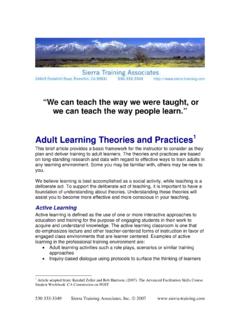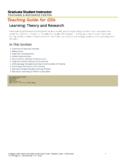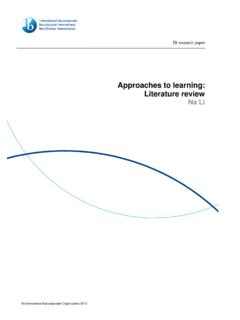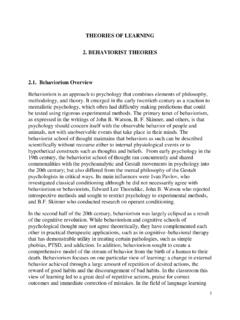Transcription of LEARNING AND TEACHING : THEORIES, APPROACHES …
1 LEARNING AND TEACHING : theories , APPROACHES AND MODELS 133 CHAPTER 10: BRAIN-BASED LEARNING Assoc. Prof. Dr. Bahad r Eri ti Anadolu University, Faculty of Education Assist. Prof. Dr. Celal Akdeniz S leyman Demirel University, Faculty of Education (Translated by Muharrem hsan irin) INTRODUCTION A considerable amount of studies on human beings or related to human nature focus on human behaviours. How human beings know, how they acquire behaviours, how and according to what they behave in which situations, the reason of the differences between behaviours, factors that affect human behaviours are some of the subjects that are studies through these studies.
2 As is known, people acquire all their abilities throughout their lives after birth except for a few innate behaviours that are species-specific. This information is very significant because it emphasizes the fact that people have a capacity that can be improved. A person can learn what a behavior means or how it is formed through his/her direct or indirect experiences, on the other hand, this person can display the said behaviour(s) whenever it is possible and the person wishes to do so. In short, except fort he innate behaviours, the answer of a substantial amount of human behaviours is hidden in the concept of learning1.
3 LEARNING is relatively permanent products of experiences that come out as a result of the interaction between individual and environment2. A part of a person s all learnings occur incidentally while an important part of it occurs in a specially structured LEARNING environment in a planned and programmed manner. The concept of LEARNING which is of vital importance in terms of explaining human behaviours is one of the important subject areas whose questions are tried to be answered in the body of literature such as how and through which processes LEARNING occurs.
4 In the historical process, there have arisen many theories that are still acceptable despite of some criticism. LEARNING theories that are interested in LEARNING and ways of LEARNING in order to understand and explain LEARNING process explain LEARNING as a process in which behaviour changes, is shaped or controlled. These theories may be classified under different headings according to some criteria. On the other hand, although these theories have some common views, they also have different points of view, which have been developed considering biological, psychological, physiological, neurological structure of human.
5 Some of these theories are stated below. In behaviorist LEARNING approach, measurability and observability of human behaviours are considered important while unobservable and immeasurable human behaviours are ignored to the extent that they are disregarded completely3. In behaviorist approach, LEARNING is explained as a process in which a stimulus and a response are matched, and a response given to a stimulus is reinforced. Behaviorist theory results from the idea that LEARNING occurs mostly through repetition, motivation and reinforcement.
6 According to this approach, there are basically two types of LEARNING . In classical conditioning, which is the first of them, a neutral stimulus is matched with an unconditioned stimulus. On the other hand, operant conditioning is behaviour is reinforced and so is more likely to repeat. As some situations about LEARNING could not be explained with the principles of behaviorist theory, researchers headed towards re-defining human LEARNING and as a result of this situation, cognitive LEARNING theories started to gain importance.
7 Cognitive approach, which claims that LEARNING cannot be explained through the connection of stimulus-response, claims that LEARNING is determined by the mental processes of learner, and states that student is not a passive receiver of external stimuli, but is LEARNING AND TEACHING : theories , APPROACHES AND MODELS 134 an individual who internalizes them and thus actively shape behaviour. Cognitive LEARNING theories examine mental processes of human while making sense of the world.
8 According to this theory, LEARNING is the change of mental structure of an individual, and it is emphasized that with this change, behaviours of a person are also changed or a person acquires new behaviours. Cognitive theorists are also interested in internal structures of individual as well as observable behaviours while explaining learning4. Another approach, which researches LEARNING , is constructivism. This theory claims that knowledge is produced by learner s value judgements and experiences. Those who defend constructivism explain LEARNING as finding and structuring knowledge by means of associating them with previous experiences and knowledge5-6.
9 According to constructivism, LEARNING is an internal process that takes place in a person s mind. A person is not passive receiver of external stimuli, but is an individual who internalizes them and thus actively shape behaviour. Constructivism is a LEARNING approach that states that learners learn something by means of using and structuring their own experiences instead of receiving knowledge in an organized form as given to them7. LEARNING is a process in which students construct their own knowledge in theie mind related to a certain object, event, phenomenon or concept or at least, in which students interpret the truth grounding on their previous experiences8.
10 We can say that views of constructivist theory and cognitive theory are similar to each other to a great extent. Brain-based LEARNING , which deals with the concept of LEARNING in a neuro-physiological context, accepts and explains the process of LEARNING as a bio-chemical or electro-chemical change. According to this approach, the process, which is called, LEARNING , is a process of establishing a connection between brain cells and an intercellular connection, and a new connection is established between brain cells with each new learning9 (Jensen, 2000).









